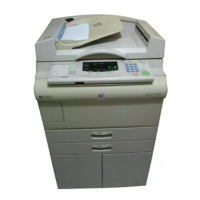6. DEVELOPMENT
6.1 OVERVIEW
When main motor rotation is transmitted to the development unit, the paddle
roller [A], development roller [B], auger [C], and agitator [D] start turning. The
paddle roller picks up developer in its paddles and transports it to the
development roller. Internal permanent magnets in the development roller
attract the developer (which is about 70 µm in diameter) to the development
roller sleeve.
The turning sleeve of the development roller then carries the developer past
the doctor blade [E]. The doctor blade trims the developer to the desired
thickness and creates developer backspill into the cross-mixing mechanism.
The development roller continues to turn, carrying the developer to the OPC
drum. When the developer brush contacts the drum surface, the negatively
charged areas of the drum surface attract and hold the positively charged
toner. In this way, the latent image is developed.
Negative bias is applied to the development roller to prevent toner from
being attracted to the non-image areas on the drum, which may have a
residual negative charge. The bias also controls image density.
After turning about 100 degrees more, the development roller releases the
developer into the development unit. The developer is agitated by the paddle
roller, agitator, and cross-mixing mechanism.
The toner density sensor [F] located under the unit measures the toner
concentration in the developer. A hole, fitted with a filter [G], has been made
in the top of the unit to relieve air pressure and to minimize toner scattering.
[E]
[B]
[A]
[F]
[D]
[C]
[G]
Detailed
Descriptions
STM 2-53 A156/A160/A162

